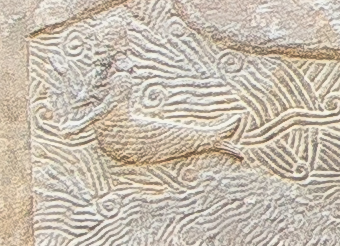Neo-Assyrian Period, ca. 713-706 BC
Within the Louvre’s Cour Khorsabad with its multitude of ancient reliefs and monumental sculptures, there hang five carved slabs, made of gypseous alabaster or Mosul marble, which depict the cutting down and transport of the mighty cedars of Lebanon. They are transported on and dragged behind boats on their way to Assyria and the site of King Sargon II’s opulent palace at Dur Sharrukin (in present-day Iraq).
The scene can be followed from right to left:
In the first slab, 28 men unload timber in the mountains of Lebanon.
In this marvelous depiction, ten boats, each with a horse’s head at the prow and a fish’s tail at the stern, are sailing over waters teeming with sea creatures. Seven are heavily loaded with posts or are towing logs behind them. The boats are sailing from two island cities fortified with a double wall, probably representing Tyre and Ruad.
In the above slab, three mythical and wondrous beings, a merman (complete with beard!) and two winged bulls, serve as guardians during the transport of the timber over the waters.
In the fourth slab, four boats are nearing the shore while two others are pulling away.

The upper part of the relief is a modern restoration. The lower part of the slab shows timber being unloaded.
And, in the last restored slab, eleven men are pulling a load with a rope. The end of a beam can be seen at the bottom. Beside the path is a pile of nine logs, trimmed and bored to take a rope.
This frieze and its depiction of the transport of Lebanese cedar is often employed by scholars to demonstrate the building of Assyrian palaces, trade, Phoenician culture and civilization, and the renown Cedars of Lebanon.
The transport operation was incredibly complex requiring detailed planning and many resources, not the least of which was the incredible strength of the men involved. Fortunately, I’m sure the winged bulls and the mermen offered tremendous support!
The actual cutting down of the trees is not portrayed here. I wonder how they completed that first part of the process…
Although not nearly as popular as the Mona Lisa and the Grande Galerie, nor as iconic as the Venus de Milo, this frieze – if you let it – along with the rest of Cour Khorsabad, could hold your attention for over an hour, as happened to me. Plus, because it is lesser well-known, the room is far less-crowded than those with the more famous pieces. When you go, give yourself the gift of time to absorb this fascinating room within the Louvre, the Cour Khorsabad, from the Palace of King Sargon II.
References and caption information:
http://www.louvre.fr/en/oeuvre-notices/frieze-transportation-timber
http://www.habeeb.com/cedar.of.lebanon/cedar.of.lebanon.info.html








Pingback: Leaving the Louvre |
Pingback: Louvre List |